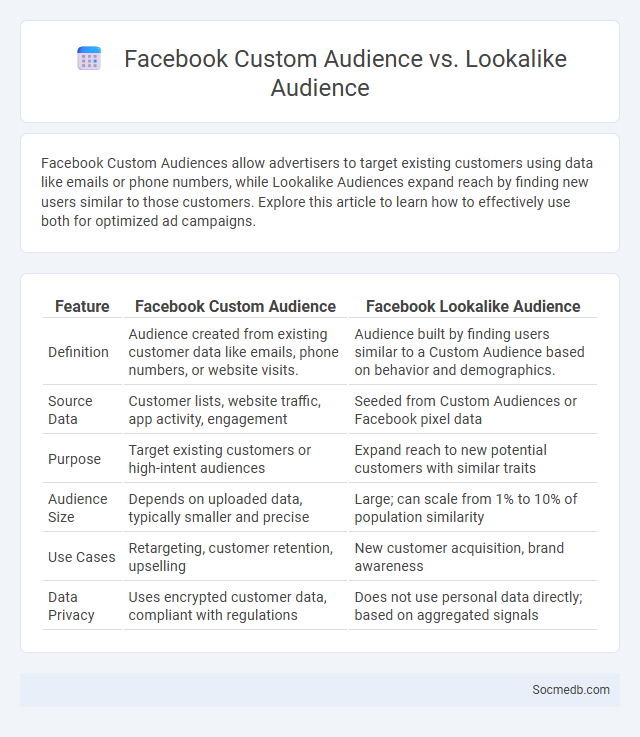
Photo illustration: Facebook Custom Audience vs Lookalike Audience
Facebook Custom Audiences allow advertisers to target existing customers using data like emails or phone numbers, while Lookalike Audiences expand reach by finding new users similar to those customers. Explore this article to learn how to effectively use both for optimized ad campaigns.
Table of Comparison
| Feature | Facebook Custom Audience | Facebook Lookalike Audience |
|---|---|---|
| Definition | Audience created from existing customer data like emails, phone numbers, or website visits. | Audience built by finding users similar to a Custom Audience based on behavior and demographics. |
| Source Data | Customer lists, website traffic, app activity, engagement | Seeded from Custom Audiences or Facebook pixel data |
| Purpose | Target existing customers or high-intent audiences | Expand reach to new potential customers with similar traits |
| Audience Size | Depends on uploaded data, typically smaller and precise | Large; can scale from 1% to 10% of population similarity |
| Use Cases | Retargeting, customer retention, upselling | New customer acquisition, brand awareness |
| Data Privacy | Uses encrypted customer data, compliant with regulations | Does not use personal data directly; based on aggregated signals |
Introduction to Facebook Audience Types
Facebook audience types include core audiences, custom audiences, and lookalike audiences, each designed to optimize ad targeting. Core audiences leverage demographic, location, interest, and behavior data for precise reach, while custom audiences allow advertisers to retarget users based on existing customer data. Lookalike audiences enable expansion by finding users similar to a brand's best customers, enhancing campaign efficiency and engagement.
What is a Facebook Custom Audience?
A Facebook Custom Audience is a targeted group created by uploading your existing customer data, such as email addresses or phone numbers, to Facebook's advertising platform. This allows you to deliver personalized ads directly to people who have already interacted with your brand, increasing ad relevance and conversion rates. Using Custom Audiences helps you maximize your ad budget by focusing on users most likely to engage with your content.
Understanding Facebook Lookalike Audiences
Facebook Lookalike Audiences leverage your existing customer data to find new users who share similar behaviors and interests, increasing the chances of engagement and conversions. By analyzing key characteristics such as demographics, interests, and activity patterns, Facebook's algorithm creates a target audience that closely resembles your best-performing customers. You can refine your campaigns by selecting different percentages of similarity, optimizing reach and relevance to boost your advertising ROI effectively.
Defining Facebook Target Audience
Defining Facebook target audience involves analyzing demographics, interests, and behaviors to create precise user segments for effective ad campaigns. By leveraging Facebook's Audience Insights and custom audience features, you can tailor your marketing strategy to reach individuals most likely to engage with Your content. Accurate audience definition maximizes ad relevance, improves ROI, and drives meaningful interactions on the platform.
Key Differences Between Custom, Lookalike, and Target Audiences
Custom audiences leverage existing customer data to retarget specific users, enhancing conversion rates through personalized ads. Lookalike audiences use algorithms to identify new users with similar behaviors and demographics to your best customers, expanding reach efficiently. Target audiences rely on predefined demographic, geographic, and interest-based parameters to broadly segment potential customers for initial brand exposure.
When to Use Custom Audience vs Lookalike Audience
Custom Audiences are ideal for targeting existing customers or website visitors by leveraging email lists, app activity, or pixel data to boost conversion rates and retention. Lookalike Audiences work best when expanding reach to new potential customers who share similar characteristics and behaviors to high-value existing users. Choosing Custom Audiences drives personalized remarketing efforts, while Lookalike Audiences optimize campaign scalability and acquisition efficiency.
Benefits of Target Audience Selection
Effective target audience selection enhances social media marketing by increasing engagement rates through tailored content that resonates with specific demographics. It improves return on investment (ROI) by directing resources toward users most likely to convert, reducing wasted ad spend. Precise audience targeting facilitates data-driven insights, allowing continuous campaign optimization and stronger brand loyalty.
Best Practices for Audience Segmentation
Effective audience segmentation on social media involves categorizing users based on demographics, interests, and online behavior to deliver personalized content that resonates deeply. Utilizing data analytics tools to track engagement metrics and user interactions enhances targeting accuracy, boosting conversion rates and campaign ROI. Your social media strategy benefits from continuous testing and refinement of segments to adapt to changing audience preferences and platform algorithms.
Optimizing Ad Campaigns with Audience Types
Optimizing ad campaigns by leveraging detailed audience types enhances targeting precision and boosts conversion rates on social media platforms like Facebook, Instagram, and LinkedIn. Utilizing audience segmentation based on demographics, interests, and behavior allows marketers to tailor ad creatives and bidding strategies, resulting in increased engagement and reduced ad spend wastage. Employing lookalike audiences and retargeting techniques further refines campaign efficiency by reaching users most likely to convert.
Conclusion: Choosing the Right Facebook Audience for Your Goals
Selecting the right Facebook audience significantly impacts campaign effectiveness by aligning targeting parameters with specific business goals. Utilizing Facebook's advanced demographic, interest, and behavior filters enhances engagement and conversion rates. Precise audience selection ensures optimal budget utilization and drives measurable ROI for your social media marketing efforts.
 socmedb.com
socmedb.com